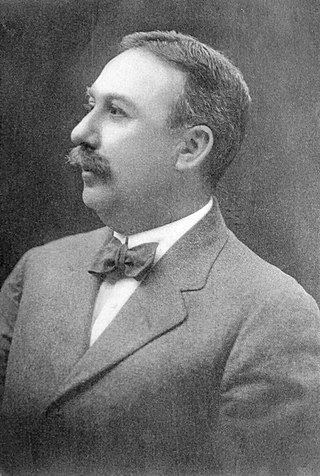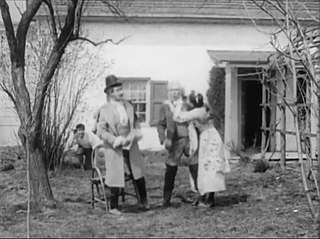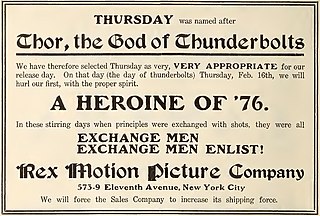Related Research Articles

Edwin Stanton Porter was an American film pioneer, most famous as a producer, director, studio manager and cinematographer with the Edison Manufacturing Company and the Famous Players Film Company. Of over 250 films created by Porter, his most important include What Happened on Twenty-third Street, New York City (1901), Jack and the Beanstalk (1902), Life of an American Fireman (1903), The Great Train Robbery (1903), The European Rest Cure (1904), The Kleptomaniac (1905), Life of a Cowboy (1906), Rescued from an Eagle's Nest (1908), and The Prisoner of Zenda (1913).

Life of an American Fireman is a short, silent film Edwin S. Porter made for the Edison Manufacturing Company. It was shot late in 1902 and distributed early in 1903. One of the earliest American narrative films, it depicts the rescue of a woman and child from a burning building. It bears notable similarities to the 1901 British short film Fire!, directed by James Williamson.

The Edison Manufacturing Company, originally registered as the United Edison Manufacturing Company and often known as simply the Edison Company, was organized by inventor and entrepreneur Thomas Edison and incorporated in New York City in May 1889. It succeeded the Edison United Manufacturing Company, founded in 1886 as a sales agency for the Edison Lamp Company, Edison Machine Works, and Bergmann & Company, which made electric lighting fixtures, sockets, and other accessories. In April 1894, the Edison laboratory's Kinetoscope operation, which was about to be commercialized, was brought under the Edison Company umbrella. In 1900, the United Edison Manufacturing Company was evidently succeeded by the New Jersey–incorporated Edison Manufacturing Company. The company's assets and operations were transferred to Thomas A. Edison, Inc. in 1911.

The Night Before Christmas is a 1905 American silent short film directed by Edwin S. Porter for the Edison Manufacturing Company. It closely follows Clement Clarke Moore's 1823 poem Twas the Night Before Christmas, and was the first film production of the poem.
Wallace McCutcheon Sr. was a pioneer cinematographer and director in the early American motion picture industry, working with the American Mutoscope & Biograph, Edison and American Star Film companies. McCutcheon's wealth of credits are often mixed up with the small handful of films directed by his son, Wallace McCutcheon Jr. (1884–1928).

Jack and the Beanstalk is a 1902 American silent trick film directed by George S. Fleming and Edwin S. Porter. With ten sequential shots, Jack and the Beanstalk was twice as long as any previous studio film. According to Porter, "It took in the neighborhood of six weeks in the spring of 1902 to successfully make this photograph."
By the Light of the Moon is a 1911 American single-reel silent film directed and filmed by Edwin S. Porter. It was produced for the Rex Motion Picture Company. It is one of the earliest examples of silhouette animation.

Faust and Marguerite is a 1900 American silent trick film produced and distributed by Edison Manufacturing Company. It was directed by Edwin S. Porter and based on the Michel Carré play Faust et Marguerite and the 1859 opera Faust adapted from the play by Charles Gounod.
Parsifal is a 1904 American silent film produced by the Edison Manufacturing Company and directed by Edwin S. Porter. It is based on the 1882 opera Parsifal by Richard Wagner, and stars Adelaide Fitz-Allen as Kundry and Robert Whittier as Parsifal.

Dream of a Rarebit Fiend is a 1906 silent trick film directed by Edwin S. Porter for Edison Manufacturing Company. It is a seven-minute live-action film adaptation of the comic strip Dream of the Rarebit Fiend by American cartoonist Winsor McCay. The film was marketed as using several special effects in which "some of the photographic 'stunts' have never been seen or attempted before."
Daniel Boone; or, Pioneer Days in America is a 1907 American silent film directed by Wallace McCutcheon and Edwin S. Porter for the Edison Manufacturing Company. It starred Florence Lawrence, often called "the first movie star."
Waiting at the Church is a 1906 American silent film directed by Edwin S. Porter for the Edison Manufacturing Company.

Kathleen Mavourneen is a 1906 silent short film by Edwin S. Porter, produced and distributed by Edison Manufacturing Company. It is based on the song “Kathleen Mavourneen” by Annie Crawford and Frederick Williams Nichols Crouch, which inspired the play by Dion Boucicault.

Kansas Saloon Smashers is a 1901 comedy short film produced and distributed by Edison Studios. Directed by Edwin S. Porter, it is a satire of American activist Carrie Nation. The film portrays Nation and her followers entering and destroying a saloon. After the bartender retaliates by spraying Nation with water, policemen order them out; the identities of the actors are not known. Inspiration for the film was provided by an editorial cartoon which appeared in the New York Evening Journal.

Rex Motion Picture Company was an early film production company in the United States.

Uncle Tom's Cabin is a 1903 American silent short drama directed by Edwin S. Porter and produced by the Edison Manufacturing Company. The film was adapted from the 1852 novel Uncle Tom's Cabin by Harriet Beecher Stowe. The plot streamlined the actual story to portray the film over the course of 19 minutes. The film was released on 3 August 1903 at the Huber's Fourteenth Street Museum in New-York.

The Train Wreckers is a 1905 American silent drama film, directed by Edwin S. Porter. In the film, the daughter of a railway switchman and lover of a locomotive engineer defeats outlaws trying to derail a train.

The 'Teddy' Bears is an American silent film directed by Edwin S. Porter and Wallace McCutcheon, and produced by the Edison Manufacturing Company starting as the fairy tale Goldilocks and ending as a political satire of United States President Theodore Roosevelt.

Life of a Cowboy is a 1906 American short silent Western film produced by Edison Manufacturing Company and directed by Edwin S. Porter.

The Whole Dam Family and the Dam Dog is a 1905 silent short comedy film directed by Edwin S. Porter for the Edison Manufacturing Company. The five-and-a-half minute film was an adaptation of a popular picture postcard featuring a humorously named family. The film introduces each member of the Dam family, and then shows a raucous dinner scene that ends with the Dam dog pulling the tablecloth off the table, and ruining the Dam meal.
References
- ↑ Niver, Kemp (1967). Motion Pictures From The Library of Congress Paper Print Collection 1894-1912. University of California Press, ISBN 978-0520009479
- ↑ Bordman, Gerald; Hischak, Thomas S. (2004). The Oxford Companion to American Theatre. Oxford University Press, ISBN 9780195169867
- ↑ Musser, Charles (1991). Before the Nickelodeon: Edwin S. Porter and the Edison Manufacturing Company. University of California Press, ISBN 9780520060807